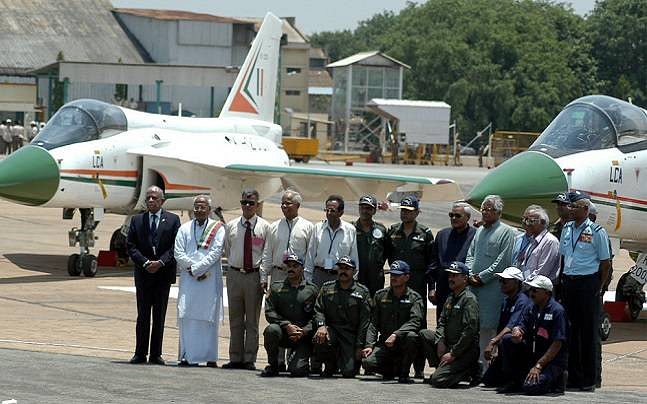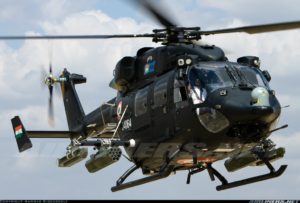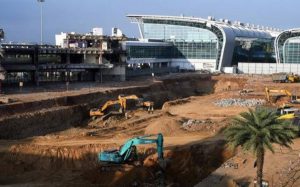
Indian Air Force to buy 83 Tejas Light Combat aircrafts from Hindustan Aeronautics Limited for Rs 45,696 crore
NEW DELHI: The Cabinet met under the Chairmanship of Prime Minister Narendra Modi in New Delhi today and has approved procurement of 73 LCA Tejas Mk-1A fighter aircrafts and 10 LCA Tejas Mk-1 Trainer aircrafts at the cost of Rs. 45,696 Crore along with Design and Development of Infrastructure sanctions worth Rs.1,202 crore.
“The CCS chaired by PM today approved the largest indigenous defence procurement deal worth about 48000 Crores to strengthen IAF’s fleet of homegrown fighter jet ‘LCA-Tejas’. This deal will be a game changer for self reliance in the Indian defence manufacturing,” said Defence Minister Rajnath Singh on his twitter account on Wednesday evening.
“The LCA Tejas is going to be the backbone of the IAF fighter fleet in (the) years to come. LCA-Tejas incorporates a large number of new technologies, many of which were never attempted in India,” Singh tweeted.
He added that the deal was a “game-changer for self-reliance in the Indian defence manufacturing (sector)”.
“Equipped with the augmented infrastructure the HAL will steer LCA-Mk1A production for timely deliveries to the IAF,” he said.
“Tejas programme would act as a catalyst for transforming the Indian aerospace manufacturing ecosystem into a vibrant, self-sustaining one.I thank the Prime Minister Shri @narendramodi for this historic decision taken by the CCS today, ” the defence minister said.
The CCS chaired by PM Sh. @narendramodi today approved the largest indigenous defence procurement deal worth about 48000 Crores to strengthen IAF’s fleet of homegrown fighter jet ‘LCA-Tejas’. This deal will be a game changer for self reliance in the Indian defence manufacturing.
— Rajnath Singh (@rajnathsingh) January 13, 2021
The LCA-Tejas is going to be the backbone of the IAF fighter fleet in years to come. LCA-Tejas incorporates a large number of new technologies many of which were never attempted in India. The indigenous content of LCA-Tejas is 50% in Mk1A variant which will be enhanced to 60%.
— Rajnath Singh (@rajnathsingh) January 13, 2021
Light Combat Aircraft Mk-1A variant is an indigenously designed, developed and manufactured state-of-the-art modern 4+ generation fighter aircraft. This aircraft is equipped with critical operational capabilities of Active Electronically Scanned Array (AESA) Radar, Beyond Visual Range (BVR) Missile, Electronic Warfare (EW) Suite and Air to Air Refuelling (AAR) would be a potent platform to meet the operational requirements of Indian Air Force, IAF.
The HAL has already set-up second line manufacturing facilities at its Nasik and Bengaluru Divisions. Equipped with the augmented infrastructure the HAL will steer LCA-Mk1A production for timely deliveries to the IAF.
— Rajnath Singh (@rajnathsingh) January 13, 2021
It is the first “Buy (Indian-Indigenously Designed, Developed and Manufactured)” category procurement of combat aircrafts with an indigenous content of 50% which will progressively reach 60% by the end of the programme.
The Cabinet has also approved infrastructure development by Indian Air Force (IAF) under the project to enable them handle repairs or servicing at their base depot so that the turnaround time would get reduced for mission critical systems and would lead to increased availability of aircraft for operational exploitation. This would enable IAF to sustain the fleet more efficiently and effectively due to availability of repair infrastructure at respective bases.
The decision taken today will considerably expand the current LCA ecosystem and help in creating new job opportunities. HAL follows a system integrator model in LCA Mk1A program and acts as an umbrella organisation, fostering manufacturing & design capabilities in pvt. industry.
— Rajnath Singh (@rajnathsingh) January 13, 2021
Under the Atmanirbhar Bharat Abhiyaan, India is continuously growing in its power to indigenously design, develop and manufacture advanced cutting edge technologies and systems in the Defence Sector. The manufacturing of Light Combat Aircraft by Hindustan Aeronautics Limited (HAL), HAL will give a further push to Atmanirbhar Bharat initiative and boost indigenisation of defence production and the defence industry in the country.
The LCA-Tejas programme would act as a catalyst for transforming the indian aerospace manufacturing ecosystem into a vibrant Atmanirbhar-self-sustaining ecosystem. I thank the Prime Minister Shri @narendramodi for this historic decision taken by the CCS today.
— Rajnath Singh (@rajnathsingh) January 13, 2021
About 500 Indian companies including MSMEs in the design and manufacturing sectors will be working with HAL in this procurement. The programme would act as a catalyst for transforming the Indian aerospace manufacturing ecosystem into a vibrant Atmanirbhar-self-sustaining ecosystem.
Tejas LCA
India has long bought its fighter jets from countries like Russia, France and Britain under a license agreement to manufacture it locally by Hindustan Aeronautics Limited. However, back in the 1980s, HAL started the Light Combat Aircraft (LCA) programme to replace the ageing Soviet sourced MiG-21.
With India’s former Prime Minister Atal Bihari Vajpayee giving the LCA its name – Tejas – the indigenously built fighter aircraft was inducted in the Indian Air Force with the IAF placing a 20 jet order initially and the first Tejas Squadron was formed in 2016 called the Flying Daggers. Till now IAF has placed an order of 40 Tejas Mk 1, including 32 single-seat aircraft and eight twin-seat trainers. IAF has also initiated procurement of a further 83 single-seat fighters in Mk 1A configuration.
Specification
Tejas LCA: The HAL-made fighter jet is ideally a single seat fighter jet but can be made into a twin seat jet depending on armed forces’ requirements, which is mostly for training purposes. The jet is light and simple as compared to other foreign-made fighter jets and is famous for its delta wing arrangement. It is powered by a single General Electric engine rated at 53.9 kN (12,100 lbf) thrust dry, 90 kN (20,200 lbf) with afterburner. It has a length of 13.2 metre and a wingspan of 8.2 metre.
The plane weighs 6500 kg (dry) and has a total takeoff weight of 13000 kg. The Tejas has a maximum speed of Mach 1.8 (2222 kmph) and can travel 500 km with drop tanks. The Tejas can carry laser guided bombs, air-to-air and air-to-surface missiles, anti-ship missiles, and has Israel’s Elta EL/M-2032 multi-mode fire control radar on board.
Aerospace Engineer from Odisha Gave India Its First LCA – Tejas
In December 2000, a US magazine carried a report which said that India would never be able to fly its own Light Combat Aircraft (LCA) due to the complexity of the technology needed and the US sanctions. On January 4, 2001, a determined team headed by Dr Kota Harinarayana successfully tested the first flight of their LCA Technology Demonstrator. The then-Prime Minister Vajpayee named the aircraft ‘Tejas’ which translates to radiance in Sanskrit, reported by TheBetterIndia.
In the early 80s, the country’s political leadership realised the need for an indigenous aircraft to replace the ageing MiG fleet. The ‘Long Term Re-Equipment Plan 1981’ cited that by the mid-1990s, these aircraft would reach “the end of their service lives”. This, in turn, would lead to a 40 per cent shortfall of such combat jets in the Indian Air Force.
In this light, the Light Combat Aircraft (LCA) programme was launched in the 1980s. It had two primary purposes: one was the replacement of the MiG-21s, and the other was to boost the advancement of India’s domestic aviation capabilities.
Back then, no single organisation had the capability to develop such an aircraft by itself. The makers of the last indigenous fighter jet, the HF 24 in 1961, had shut shop. Hence, the only way for the LCA programme to succeed was to start from scratch.
In 1984, the government appointed the Aeronautical Development Agency (ADA) to handle the LCA programme along with Hindustan Aeronautics Limited (HAL) and other institutions. At that time, V.S. Arunachalam was the scientific adviser to the defence minister. A former scientist at Defence Research and Development Organization (DRDO), he, in turn, chose a young design engineer from Odisha as the director of India’s fledgeling indigenous aircraft programme.
Born at Badabazar in Berhampur district of Odisha in 1943, Kota Harinarayan completed his school education from City High School before cracking both engineering and medical entrance exams.
He chose to pursue engineering and obtained a degree in mechanical engineering from Banaras Hindu University.
Attracted towards a career in aerospace from a young age, he followed this by joining the Indian Institute of Science in Bengaluru for a course in aerospace engineering. Later, he joined Hindustan Aeronautics Limited (HAL) in Bangalore, India’s largest plane-maker, as a design engineer.
In 1982, Harinarayan was working as the chief designer at HAL’s Nasik division when he was selected by Arunachalam as the Director of DRDO’s Aeronautical Development Agency. At that time, there simply wasn’t enough aeronautical talent in DRDO. True, HAL had built a fighter aircraft called the Marut in 1961 but it was designed by a German team (it remained in service till 1990).
So, his first step was to bring together the country’s best talent in the field of aerospace engineering. For this purpose, he recruited engineers, scientists and professionals from twenty educational institutions like the IITs and forty Research and Development (R&D) laboratories like HAL and CSIR. In a year, ADA had a team of about 400 engineers and scientists.
Now the team was in place but another problem cropped up — it did not have the right computer for designing. So Rajiv Gandhi, then prime minister, stepped in. During his visit to the United States soon after, he convinced President Ronald Reagan to give the IBM 390 computer for the design work of the Tejas.
ADA next bought CATIA (computer-aided three-dimensional interactive application), the computer-aided design software developed by Dassault, in the early ’90s. However, when ADA started its work, it had a tough time buying electronic components since several embargoes and sanctions had been imposed on India by Western nations in reaction to the Pokhran tests.
This, however, made the team more determined to accomplish their difficult task of designing each element of the design, each raw material for the plane, from scratch.

